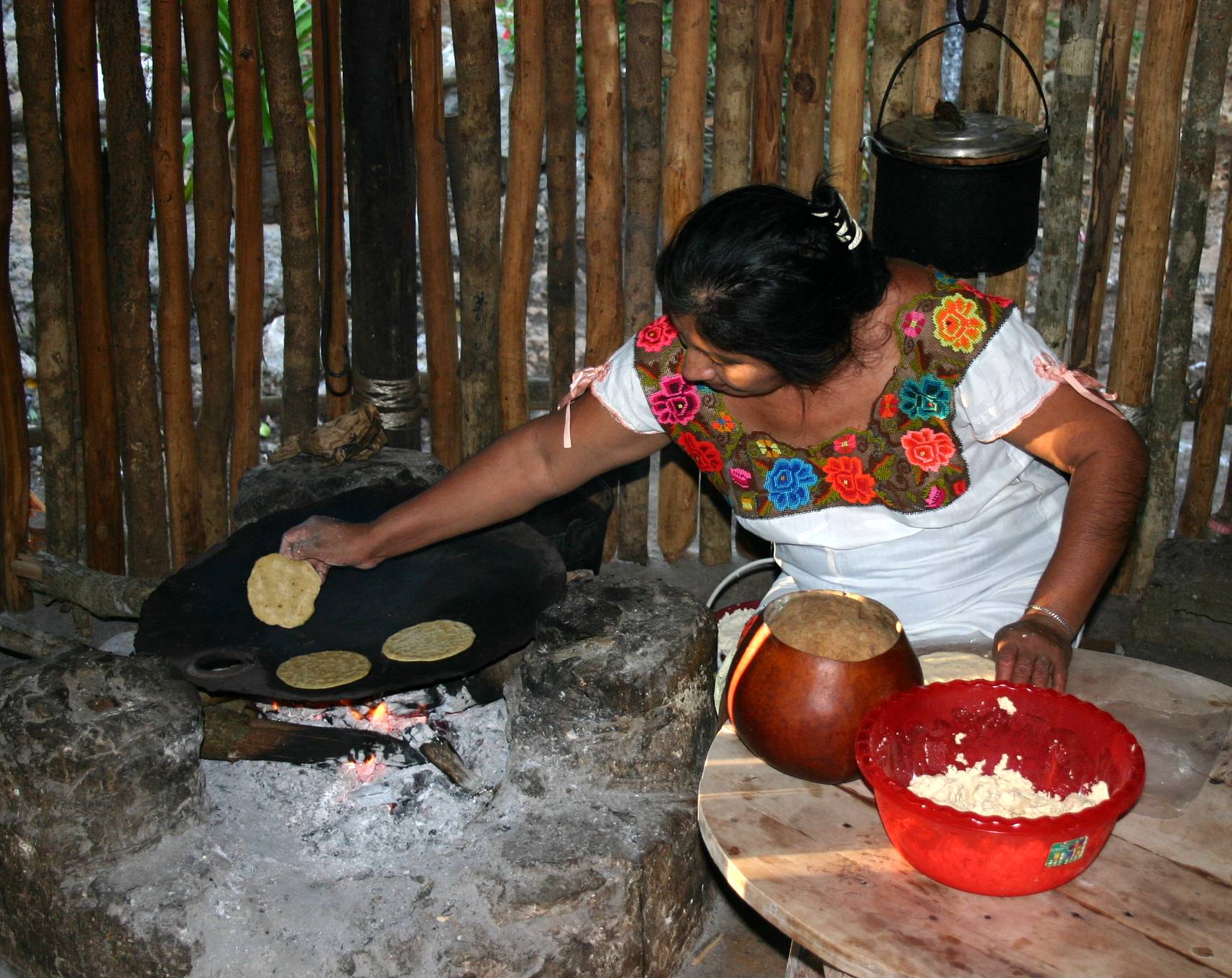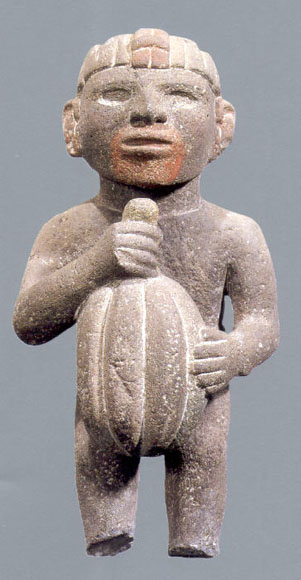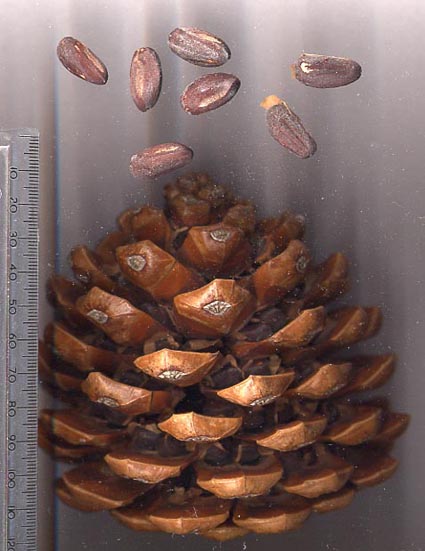|
Tascalate
Tascalate (alternative spelling Tazcalate) is a chocolate drink made from a mixture of roasted maize, roasted cocoa bean, ground pine nuts, achiote and sugar or panela, very common in the Mexican state of Chiapas Chiapas, officially the Free and Sovereign State of Chiapas, is one of the states that make up the Political divisions of Mexico, 32 federal entities of Mexico. It comprises Municipalities of Chiapas, 124 municipalities and its capital and large .... Tascalate means tortilla water (agua de tortilla) and their origins can be rooted to their noble prehispanic lineage. Ingredients could vary, so that some variants are dominated by the taste of roasted corn, whilst other mixtures are dominated by chocolate flavor. But actually the ingredients are mostly standardized without major variations. For preparing the hot drink, the ground ingredients are mixed with milk and heated. For a cold drink, ingredients are stirred in cold water and consumed with ice cubes. References ... [...More Info...] [...Related Items...] OR: [Wikipedia] [Google] [Baidu] |
Mexico
Mexico, officially the United Mexican States, is a country in North America. It is the northernmost country in Latin America, and borders the United States to the north, and Guatemala and Belize to the southeast; while having maritime boundary, maritime boundaries with the Pacific Ocean to the west, the Caribbean Sea to the southeast, and the Gulf of Mexico to the east. Mexico covers 1,972,550 km2 (761,610 sq mi), and is the List of countries by area, thirteenth-largest country in the world by land area. With a population exceeding 130 million, Mexico is the List of countries by population, tenth-most populous country in the world and is home to the Hispanophone#Countries, largest number of native Spanish speakers. Mexico City is the capital and List of cities in Mexico, largest city, which ranks among the List of cities by population, most populous metropolitan areas in the world. Human presence in Mexico dates back to at least 8,000 BC. Mesoamerica, considered a cradle ... [...More Info...] [...Related Items...] OR: [Wikipedia] [Google] [Baidu] |
Tortilla
A tortilla (, ) is a thin, circular unleavened flatbread from Mesoamerica originally made from maize hominy meal, and now also from wheat flour. The Aztecs and other Nahuatl speakers called tortillas ''tlaxcalli'' (). First made by the indigenous peoples of Mesoamerica before colonization, tortillas are a cornerstone of Mesoamerican cuisine. Corn tortillas in Mesoamerica are known from as early as 500 BCE. Etymology The word ''tortilla'' is derived from the Spanish word ''torta'', meaning "cake," plus the diminutive -''illa''; as a result, the word means "little cake" in Spanish. Varieties Corn Tortillas made from nixtamalized maize meal (''masa de maíz'') are the oldest variety of tortilla. They originated in Mexico and Central America, and remain popular throughout the Americas. Peoples of the Oaxaca region in Mexico first made tortillas at the end of the Villa Stage (1500 to 500 BCE). Towards the end of the 19th century, the first mechanical utensils for making t ... [...More Info...] [...Related Items...] OR: [Wikipedia] [Google] [Baidu] |
Canella
''Canella'' is a monospecific genus containing the species ''Canella winterana'', a tree native to the Caribbean from the Florida Keys to Barbados. Its bark is used as a spice similar to cinnamon, giving rise to the common names cinnamon bark, wild cinnamon, and white cinnamon. Description Flowers perfect, regular; sepals 3, imbricated, persistent; petals 5, imbricated; stamens monadelphous. Fruit baccate, indehiscent, 2 to 4-seeded. A tree, with scaly aromatic bark, stout ashy gray branchlets conspicuously marked with large orbicular leaf-scars. Leaves petiolate, alternate, destitute of stipules, penniveined, entire, pellucid-punctate, coriaceous. Flowers arranged in a many-flowered subcorymbose terminal or subterminal panicle composed of several dichotomously branched cymes from the axis of the upper leaves or of minute caducous bracts. Sepals suborbiculate, concave, coriaceous, erect, their margins ciliate. Petals hypogynous, in a single row on the slightly convex receptacl ... [...More Info...] [...Related Items...] OR: [Wikipedia] [Google] [Baidu] |
Cocoa Bean
The cocoa bean, also known as cocoa () or cacao (), is the dried and fully fermented seed of ''Theobroma cacao'', the cacao tree, from which cocoa solids (a mixture of nonfat substances) and cocoa butter (the fat) can be extracted. Cacao trees are native to the Amazon rainforest. They are the basis of chocolate and Mesoamerican foods including tejate, an indigenous Mexican drink. The cacao tree was first domesticated at least 5,300 years ago by the Mayo-Chinchipe culture in South America before it was introduced in Mesoamerica. Cacao was consumed by pre-Hispanic cultures in spiritual ceremonies, and its beans were a common currency in Mesoamerica. The cacao tree grows in a limited geographical zone; today, West Africa produces nearly 81% of the world's crop. The three main varieties of cocoa plants are Forastero, Criollo, and Trinitario, with Forastero being the most widely used. In 2024, global cocoa bean production reached 5.8 million tonnes, with Ivory Coast leading a ... [...More Info...] [...Related Items...] OR: [Wikipedia] [Google] [Baidu] |
Annatto
Annatto ( or ) is an orange-red condiment and food coloring derived from the seeds of the achiote tree (''Bixa orellana''), native to tropics, tropical parts of the Americas. It is often used to impart a yellow to red-orange color to foods, but sometimes also for its flavor and aroma. Its scent is described as "slightly peppery with a hint of nutmeg" and its flavor as "slightly nutty, sweet, and peppery". The color of annatto comes from various carotenoid pigments, mainly bixin and norbixin, found in the reddish waxy coating of the seeds. The condiment is typically prepared by grinding the seeds to a powder or paste. Similar effects can be obtained by extracting some of the color and flavor principles from the seeds with hot water, oil, or lard, which are then added to the food. Annatto and its extracts are now widely used in an artisanal or industrial scale as a coloring agent in many processed food products, such as cheeses, spread (food), dairy spreads, butter and margarine, ... [...More Info...] [...Related Items...] OR: [Wikipedia] [Google] [Baidu] |
Sugar
Sugar is the generic name for sweet-tasting, soluble carbohydrates, many of which are used in food. Simple sugars, also called monosaccharides, include glucose Glucose is a sugar with the Chemical formula#Molecular formula, molecular formula , which is often abbreviated as Glc. It is overall the most abundant monosaccharide, a subcategory of carbohydrates. It is mainly made by plants and most algae d ..., fructose, and galactose. Compound sugars, also called disaccharides or double sugars, are molecules made of two bonded monosaccharides; common examples are sucrose (glucose + fructose), lactose (glucose + galactose), and maltose (two molecules of glucose). White sugar is almost pure sucrose. In the body, compound sugars are hydrolysed into simple sugars. Longer chains of monosaccharides (>2) are not regarded as sugars and are called oligosaccharides or polysaccharides. Starch is a glucose polymer found in plants, the most abundant source of energy in human foo ... [...More Info...] [...Related Items...] OR: [Wikipedia] [Google] [Baidu] |
Panela
Panela () or rapadura (Portuguese pronunciation: ) is an unrefined whole cane sugar, typical of Latin America. It is a solid form of sucrose derived from the boiling and evaporation of sugarcane juice. Panela is known by other names in Latin America, such as ''chancaca'' in Chile, Bolivia, and Peru, ''piloncillo'' in Mexico (where ''panela'' refers to a type of cheese, '' queso panela''). Just like brown sugar, two varieties of ''piloncillo'' are available; one is lighter () and one darker (''oscuro''). Unrefined, it is commonly used in Mexico, where it has been around for at least 500 years. Made from crushed sugar cane, the juice is collected, boiled, and poured into molds, where it hardens into blocks. It is similar to jaggery, which is used in South Asia. Both are considered non-centrifugal cane sugars. Panela is sold in many forms, including liquid, granulated, and solid blocks, and is used in the canning of foods, as well as in confectionery, soft drinks, baking, and ... [...More Info...] [...Related Items...] OR: [Wikipedia] [Google] [Baidu] |
Chocolate
Chocolate is a food made from roasted and ground cocoa beans that can be a liquid, solid, or paste, either by itself or to flavoring, flavor other foods. Cocoa beans are the processed seeds of the cacao tree (''Theobroma cacao''); unprocessed, they taste intensely bitter. In making chocolate, these seeds Cocoa bean fermentation, are usually fermented to develop the flavor. They are then dried, cleaned, and roasted. The shell is removed to reveal nibs, which are ground to chocolate liquor: unadulterated chocolate in rough form. The liquor can be processed to separate its two components, cocoa solids and cocoa butter, or shaped and sold as unsweetened baking chocolate. By adding sugar, sweetened chocolates are produced, which can be sold simply as dark chocolate (a.k.a., plain chocolate), or, with the addition of milk, can be made into milk chocolate. Making milk chocolate with cocoa butter and without cocoa solids produces white chocolate. In some chocolates, other ingredients ... [...More Info...] [...Related Items...] OR: [Wikipedia] [Google] [Baidu] |
Maize
Maize (; ''Zea mays''), also known as corn in North American English, is a tall stout grass that produces cereal grain. It was domesticated by indigenous peoples in southern Mexico about 9,000 years ago from wild teosinte. Native Americans planted it alongside beans and squashes in the Three Sisters polyculture. The leafy stalk of the plant gives rise to male inflorescences or tassels which produce pollen, and female inflorescences called ears. The ears yield grain, known as kernels or seeds. In modern commercial varieties, these are usually yellow or white; other varieties can be of many colors. Maize relies on humans for its propagation. Since the Columbian exchange, it has become a staple food in many parts of the world, with the total production of maize surpassing that of wheat and rice. Much maize is used for animal feed, whether as grain or as the whole plant, which can either be baled or made into the more palatable silage. Sugar-rich varieties called sw ... [...More Info...] [...Related Items...] OR: [Wikipedia] [Google] [Baidu] |
Pine Nuts
Pine nuts, also called piñón (), pinoli (), or pignoli, are the edible seeds of pines (family Pinaceae, genus ''Pinus''). According to the Food and Agriculture Organization, only 29 species provide edible nuts, while 20 are traded locally or internationally owing to their seed size being large enough to be worth harvesting; in other pines, the seeds are also edible but are too small to be of notable value as human food. The biggest producers of pine nuts are China, Russia, North Korea, Pakistan and Afghanistan. As pines are gymnosperms, not angiosperms (flowering plants), pine nuts are not " true nuts"; they are not botanical fruits, the seed not being enclosed in an ovary which develops into the fruit, but simply bare seeds—"gymnosperm" meaning literally "naked seed" (from and ). The similarity of pine nuts to some angiosperm fruits is an example of convergent evolution. Species and geographic spread In Asia, two species, in particular, are widely harvested: Korean ... [...More Info...] [...Related Items...] OR: [Wikipedia] [Google] [Baidu] |
Achiote
''Bixa orellana'', also known as achiote, is a shrub or small tree native to Central America. ''Bixa orellana'' is grown in many countries worldwide. The plant is best known as the source of annatto, a natural orange-red condiment (also called or ) obtained from the waxy arils that cover its seeds. The ground seeds are widely used in traditional dishes in Central and South America, Mexico, and the Caribbean, such as ''cochinita pibil'', chicken in , , and . Annatto and its extracts are also used as an industrial food coloring to add yellow or orange color to many products such as butter, cheese, margarine, ice creams, meats, and condiments. Some of the indigenous peoples of North, Central, and South America originally used the seeds to make red body paint and lipstick, as well as a spice. For this reason, the ''Bixa orellana'' is sometimes called the lipstick tree. Etymology and common names The name ''Bixa orellana'' was given by Linnaeus. The botanical genus name derives ... [...More Info...] [...Related Items...] OR: [Wikipedia] [Google] [Baidu] |
Panela
Panela () or rapadura (Portuguese pronunciation: ) is an unrefined whole cane sugar, typical of Latin America. It is a solid form of sucrose derived from the boiling and evaporation of sugarcane juice. Panela is known by other names in Latin America, such as ''chancaca'' in Chile, Bolivia, and Peru, ''piloncillo'' in Mexico (where ''panela'' refers to a type of cheese, '' queso panela''). Just like brown sugar, two varieties of ''piloncillo'' are available; one is lighter () and one darker (''oscuro''). Unrefined, it is commonly used in Mexico, where it has been around for at least 500 years. Made from crushed sugar cane, the juice is collected, boiled, and poured into molds, where it hardens into blocks. It is similar to jaggery, which is used in South Asia. Both are considered non-centrifugal cane sugars. Panela is sold in many forms, including liquid, granulated, and solid blocks, and is used in the canning of foods, as well as in confectionery, soft drinks, baking, and ... [...More Info...] [...Related Items...] OR: [Wikipedia] [Google] [Baidu] |







